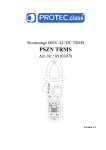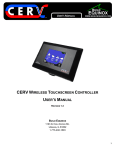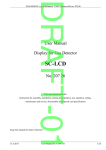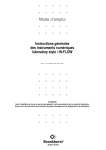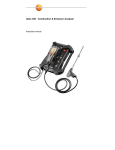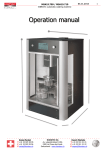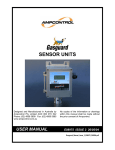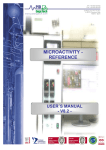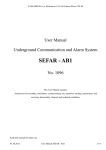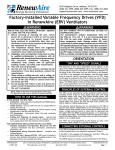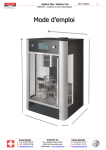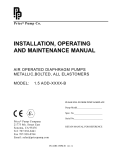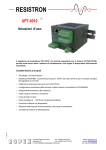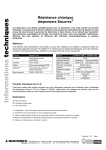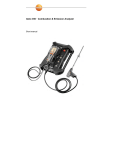Download - ZAM
Transcript
ZAM-SERVIS s.r.o. Křišťanova 1116/14 Ostrava-Přívoz 702 00 User manual Stationary sensor of toxic gases SC-TOX No. documentation: 20907 This user manual includes: Instructions for assembling, installation, putting into operation, use, operation, setting, maintenance and servicing, dismantling, disposal and technical conditions 18.4.2013 User manual SC-TOX 1/40 ZAM-SERVIS s.r.o. Křišťanova 1116/14 Ostrava-Přívoz 702 00 Contents User manual:..................................................................................................................................................4 Use.................................................................................................................................................................4 Warning!...................................................................................................................................................4 Warning!....................................................................................................................................................4 Warning!...................................................................................................................................................4 Warning!...................................................................................................................................................5 Description and function................................................................................................................................6 Assembling and installation...........................................................................................................................8 Control calibration and settings of SC-TOX................................................................................................10 Entering the calibration and setting mode...............................................................................................10 Warning!.................................................................................................................................................10 Calibration of SC-TOX......................................................................................................................10 Confirmation of zero concentration by SC-TOX (except the O2 sensor)..........................................11 Setting of measurement of SC-TOX.......................................................................................................11 Temperature compensation. ...............................................................................................................11 ............................................................................................................................................................12 Analog output. ...................................................................................................................................12 Digital, binary output. ........................................................................................................................12 Digital frequency output. ...................................................................................................................12 LED indicators....................................................................................................................................12 Other setting of SC-TOX........................................................................................................................13 Access code, new sensor.....................................................................................................................13 Special states, calibration states........................................................................................................13 Limit of age of calibration, sensor and network addres.....................................................................13 Factory parameter settings......................................................................................................................13 Saving of settings....................................................................................................................................14 Reading of saved data.............................................................................................................................14 Overview of parameters of SC-TOX...........................................................................................................15 General faults of the sensor SC-TOX..........................................................................................................16 Faults and special states detected by the sensor SC-TOX...........................................................................17 Operating instructions..................................................................................................................................18 Warning!.................................................................................................................................................18 Maintenance.................................................................................................................................................18 Repairs and spare parts................................................................................................................................18 Manufacturer and servicing organisation.....................................................................................................18 Delivering, transport and storage.................................................................................................................19 Fire safety, ecology, disposal, recycling......................................................................................................19 Related standards. Regulations and documents...........................................................................................20 Technical parameters and appearance..........................................................................................................21 Basic technical parameters .....................................................................................................................21 Table of sensors.......................................................................................................................................23 Cross dependencies of sensors................................................................................................................26 Other gases and vapours detectable by electrochemical sensors SC-TOX.............................................31 Table of gases, properties and toxicity ...................................................................................................32 Max. resistance of a power supply line loop for some sources (backlight off, output 1mA).................33 Attainable distance..................................................................................................................................33 Conversion characteristic, range 0-500ppm on the analog output 4-20mA............................................34 Internal limitation of maximum current and voltage .............................................................................34 Supplement A: To sensors equipped with M12 connectors.........................................................................36 General....................................................................................................................................................36 18.4.2013 User manual SC-TOX 2/40 ZAM-SERVIS s.r.o. Křišťanova 1116/14 Ostrava-Přívoz 702 00 Warning!.................................................................................................................................................36 Use...........................................................................................................................................................36 Description..............................................................................................................................................36 Installation and assembly........................................................................................................................37 Operating instructions.............................................................................................................................37 Warning!.................................................................................................................................................37 Connection..........................................................................................................................................38 Disconnection.....................................................................................................................................38 Connector figures....................................................................................................................................39 Maintenance............................................................................................................................................40 Repairs and spare parts............................................................................................................................40 Document revision.......................................................................................................................................40 18.4.2013 User manual SC-TOX 3/40 ZAM-SERVIS s.r.o. Křišťanova 1116/14 Ostrava-Přívoz 702 00 User manual: This user manual includes instructions for assembling, installation, putting into operation, use, operation, setting, maintenance and servicing, dismantling, disposal and technical conditions. All workers carrying out installation, putting into operation, operation, maintenance and servicing shall be acquainted demonstrably with this operation manual. Keep this manual for further. Use ● The sensor SC-TOX is designed for permanent measurement of volumetric concentrations of various toxic gases, oxygen or hydrogen. The non-explosive design I M1/II 2GD Ex ia I/IIC T135°C allows use even in spaces with risk of explosion of SNM in coal mines or zones 1, 2, 21 and 22. According to the type of electrochemical sensor, the detector can measure these particular gases: O2, CO, H2S, NH3, SO2, H2, HCN, NO2, O3, Cl2, F2, HF, ClO2, COCl2, PH3, AsH3, SiH4. Cross dependencies of electrochemical sensors enable measurement of other gases. Warning! Basically, the sensor is an electrochemical cell and its electrolyte is subject to depletion and dehydration. This occurs even if it is not used. That is why the sensor has a limited service life and cannot be stored for a long time. Sensor warranty period is 6 months. Warning! The detector manufactured for a particular sensor / gas cannot be changed to detection of another gas by mere replacement of the sensor. An individual internal wiring is for each type of detector. Changing to another type of sensor / gas can only be carried out by the manufacturer in the workshop. Warning! • • • • • • • When handling toxic gases it is necessary to be extremely careful !!! It is recommended to carry out calibration of the sensor using gas at least once per 30 days; however, this may be carried out more frequently. In case the particular gas is not available, calibration can be carried out using cross dependence of the sensor on other gases. Dusty or damaged filter or grid in the sensor head shall be replaced. In case of operation in dusty or humid areas the filter shall be replaced before each calibration of the sensor or more frequently, depending of particular operating conditions. Foreign chemical substances, fire fumes or lack of oxygen may impair measurement results. Sudden changes of pressure may influence measurement of gas. Low humidity may dry electrolyte in the sensor. Leakage current in the cable with a current analog output or a voltage drop with the voltage analog output may cause measurement errors in the linked equipment. The warning LED and output transistor are not latch types. The function of self-holding of alarm shall be realised in the linked equipment. Installation, assembling and settings shall be carried out by a qualified person. In organisations subject to supervision of state mining administration it is necessary to follow the respective regulations. 18.4.2013 User manual SC-TOX 4/40 ZAM-SERVIS s.r.o. Křišťanova 1116/14 Ostrava-Přívoz 702 00 • • In case the sensor is exposed to a concentration exceeding the measuring range, it indicates that the range was exceeded. Then the user shall proceed according to the organisation emergency plan. End of danger can be found e.g. using a hand-held instrument that can be switched on out of the zone of danger and approached to the sensor and at the same time the data on the display are still watched. After decrease of concentration to the acceptable level it is possible to manipulate with the sensor. It is necessary to re-calibrate the sensor using gas, and then re-calibrate it again after 24 hour and again after 48 hours. The specific application, use or linkage to other devices might develop further requirements for operation, checks and maintenance of SC-CH4. These may be implied by relevant standards and technical recommendations concerning an application, operating assembly or a functional group as created. Introduction of such additional requirements to the application user is the responsibility of supplier of such application, operating assembly or a functional group. Warning! The SC-... sensor checking and testing may only be carried out by the calibration gas, the concentration of which is within the measuring span of the detector. Testing by any other backup procedure is not permitted as it may result in instantaneous damage to the detector and the loss of its functionality. That is why similar tests using a cigarette lighter and fabric soaked in various chemicals, etc. are prohibited! 18.4.2013 User manual SC-TOX 5/40 ZAM-SERVIS s.r.o. Křišťanova 1116/14 Ostrava-Přívoz 702 00 Description and function ● ● ● ● ● ● ● ● The device body is made up of a polyester box with antistatic finish. It also includes a cable grommet, fixing bars, setting pushbuttons, LED indicators and measuring heads with grids and filters, through which the measured gas is brought by natural diffusion to the electrochemical sensor. The version P allows switching on orange backlight of the display. The version L has no backlight, but the display is visible better than on the version P with backlight switched off. The 3-electrode electrochemical sensor consists of a Sensing, Counter and Reference electrodes that enable to keep constant potential of the detecting electrode. The sensors of O 2 are only fitted with 2 electrodes (S and C), special sensors are fitted with 4 electrodes. An electrolyte and a diffusion barrier are inside the sensor; the diffusion barrier direct flow of the measured gas onto the detecting electrode, where gas reduces or oxidizes and creates positive or negative current that is proportional to volumetric concentration of the measured gas. Current from the detecting electrode is inverted and voltage-amplified and converted to digital values that are then processed by an internal micro-controller. The micro-controller software performs correction of the measured concentration according to two calibration constants (amplification and offset), temperature compensation of concentration according to fixed constants of temperature dependence of signals of individual sensors, automatic drift of the offset (if signal drops under zero level. The sensor carries out checks of external power supply (10 to 30V), internal power supply (3 to 3.3V), voltage of centre of symmetric power supply, checks of temperature under the sensor, internal checks of memory (FLASH, RAM and FRAM). Further software counts and checks age of the sensor and calibration (if the sensor is on), saves the values into its internal memory (every minute cyclically for a period of 24 hours), etc. Measured concentration is shown on the display (on version P with adjustable backlight) and converted into analog output (voltage or current output with freely adjustable range from 0 to 5.0V or 22.0mA). The analog output is also used for transfer of information about special states, running calibration or exceeded range. The analogue output is active; it is a current and voltage source. The digital output can be closed (or open) until the adjustable limit of concentration (or temperature) is reached, or it can send the measured concentration (or temperature) by a frequency signal with freely adjustable range from 1 to 999Hz. The transistor output can be configured using internal jumpers as an ordinary switch or output type NAMUR s with resistors 1k and 10k; further it can be galvanic-separated from power supply or connected to the positive supply branch as an output type PNP. All adjustments, calibrations, reading of actual quantities and values from the memory are accessible using two pushbuttons on side of the case. Information on the display can be shown in Czech, Russian or English. The calibration mode and settings are accessible after entering a 4digit password. The version R with communication RS485-IS (protocol Modbus ASCII or RTU) enables reading of actual values of concentration, internal temperature, internal and external voltage, operating status of the sensor or history of these data from the internal memory (saved every minute cyclically for a period of 24 hours). The version J with tongue contacts enables, by attaching a magnet to side of the case, reversal of polarity of the analog output; this indicates for some systems that there is just carried out e.g. calibration. The sensor can be connected to systems DKD2000, PNS and other systems using a current, voltage or frequency signal or using a protocol Modbus ASCII or RTU. 18.4.2013 User manual SC-TOX 6/40 ZAM-SERVIS s.r.o. Křišťanova 1116/14 Ostrava-Přívoz 702 00 SC-TOX input-output circuits Example of wiring with a mining data concentrator DKD2000. The frequency output of SC-TOX is set to 200-600Hz a synchro-pulse 200us. The jumper H52-PNP connects internal terminals 3 and 5. The sensor can be connected to any frequency inputs of DKD2000. Max. resistance of power supply line loop of DKD2000 against the surface power supply line is 450Ω for 1 sensor and 300Ω for 2 sensors. Example of wiring with a current converter MM5041DCx. The current output of SC-TOX is set to 0.21mA. 18.4.2013 User manual SC-TOX 7/40 ZAM-SERVIS s.r.o. Křišťanova 1116/14 Ostrava-Přívoz 702 00 Example of wiring with the cabinet PNS 04/M. The current output of SC-TOX is set to 0.2-1mA. Max. power supply line loop of PNS against the surface power supply line is 800Ω. Example of wiring with an insulation switching amplifier and spark-safe source. The frequency output of SC-TOX is set. The jumper H52-10k provides output type NAMUR.. Example of wiring with an insulation switching amplifier and spark-safe source. The frequency output of SC-TOX is set. The jumper H52-10k provides output type NAMUR. Assembling and installation 1. Choose the place of installation to minimise vibrations, mechanical stress, disturbing electromagnetic fields and temperature, wind, dust and humidity conditions. Before use check good condition of the case, cable grommets, sealing, grids and filter. SC-TOX should be fixed to a solid surface through fixing bars and 4 screws Ø 4mm on a place where increased concentration of gas can be expected or near to an electric equipment that has to switched off in case of increased concentration of gas. For gases having lower specific density than air (H2, NH3, HCN) it is recommended to install the sensor at the ceiling; for gases having specific density similar to air (O 2, CO, H2S, F2, HF, PH3, SiH4) at the operator’s level and for gases heavier than air (SO2, NO2, O3, Cl2, ClO2, COCl2, AsH3) at the floor. The wind must not blow towards the sensor, but from behind or from the side and the potential condensation must not run to the sensor. The best thing is that the detector is directed with its sensor downwards or horizontally in 18.4.2013 User manual SC-TOX 8/40 ZAM-SERVIS s.r.o. Křišťanova 1116/14 Ostrava-Přívoz 702 00 the wind direction. 2. Installation of the sensor in spaces with a risk of explosion shall comply with this user manual, local operating regulations, ČSN EN 50303, ČSN EN 50394-1, ČSN EN 60079-0, ČSN EN 60079-11, ČSN EN 60079-25 and other applicable regulations and standards. 3. Analog inputs of the linked equipment can be connected to screw-free terminals 1 and 2. Supply voltage 10 to 30V from a spark-safe source is connected to terminals 3 and 4. Galvanic-separated transistor output is brought to terminals 5 and 6. Communication wires A and B are connected to terminals 7 and 8 (only version with RS485-IS). The terminating resistor on the bus RS485-IS is connected to H51 using two jumpers. Carry out electric configuration of the digital output using jumpers connected to H52. The cross section of wires is max. 2.5mm 2 for wires and 1.5mm2 for stranded wires,he wire stripping length is 5-6 mm. Any ends of wires shall not remain free. When manipulating with the sensor pay special attention that electronic part of the sensor is not damaged. 4. Diameter of the cable in the grommet M20 may be 6-12mm. Use only for fixed installation of the cable. The grommet shall be properly tightened to clamp and seal the cable. Installation shall guarantee that the cable will not be exposed to any tension and torsion in the grommet. After completion of installation it is necessary to install and seal properly the cover of the case. 5. Set the desired parameters of the sensor and after approx. 30 minutes carry out its calibration as described in the following chapter. Terminal block and setting jumpers of SC-TOX 18.4.2013 User manual SC-TOX 9/40 ZAM-SERVIS s.r.o. Křišťanova 1116/14 Ostrava-Přívoz 702 00 Control calibration and settings of SC-TOX zam servis 00123 ppm calib» CO list» Attach magnet here to swich the analog output polarity (Calibration indication, only SC-TOX-xJxx) ON ALARM Upper button calib » Enter the calibration and settings mode OK» Shift on set values OK» Confirm set or selected value +» Increase data history in minutes Lower button list» Entrer reading of stored data list» Shift on stored values +» Increase set or select stored value All settings, calibration, reading of actual quantities and values from the memory can be carried out using two pushbuttons on side of the case. During settings the functioning of SC-TOX is not limited and the sensor is fully functional according to original settings. Thanks to this fact the parameters can be checked without influencing functions of the sensor. Entering the calibration and setting mode In case the screen is in the measurement mode, pressing of the upper pushbutton calib» enters the calibration and setting mode. The screen language is the first option. The lower pushbutton selects Czech, Russian or English, the upper pushbutton OK» confirms the option. Further there can be entered a 4-digit access code. The lower pushbutton +» changes the digits, the upper pushbutton OK» moves you on the digits and confirms the entered code. Unless the code has been changed, the implicit factory value is 0000. In case that correct code is not entered, the screen returns back to the measurement mode. If you forget your access code, it is possible to restore it by default setting in the service centre only. Warning! When handling toxic gases, utmost care must be taken! There is a risk of health impairment. Calibration of SC-TOX Now the sensor can be calibrated by entering ANO or skip this option by entering NE. The lower pushbutton +» selects YES or NO, the upper pushbutton OK» confirms the option. Calibration should be carried out on a sensor that is in operation for at least 30 minutes. First enter volumetric density of the gas 18.4.2013 User manual SC-TOX 10/40 ZAM-SERVIS s.r.o. Křišťanova 1116/14 Ostrava-Přívoz 702 00 that will be used for calibration (usually 10 to 50% of the measuring range) and confirm it by the pushbutton OK».. In case the sensor is connected to a system with indication of calibration by reversing the polarity, attach a magnet to side of the case as required by the system. Now carry out a two-point calibration. Fill it with zero gas, i.e. synthetic air (pure nitrogen for O2 sensor) with flow about 0.1 to 0.5 l/min and wait for stabilisation of reading of the displayed concentration. After stabilisation (approx. 1 minute) press the pushbutton OK». Now fill it with the gas, whose concentration was entered and again wait for stabilisation of reading of the displayed concentration. After stabilisation press the pushbutton OK». The recommended exposure time calibration gas at the calibration time is three times the T90. In case that stabilisation takes too much time (more than triple the time T90) at a constant flow, probably the filter is dusty and shall be replaced. In case of dusty and humid areas replace the filter before each calibration. The sensor will measure according to new calibration after saving of the values at the end of the setting mode, so that in case of any doubts about correct calibration, the values should not be saved. The running calibration can be indicated on analog and frequency output according to other settings and after saving the values the counter of age of calibration is reset to zero. Confirmation of zero concentration by SC-TOX (except the O2 sensor) Unless the operating conditions allow frequent calibration using a test gas, a simplified calibration of zero can be carried out in case that some zero gas (synthetic air) is available or there is certainty that the sensor is just exposed to atmosphere with pure air. If possible, calibration should be carried out on a sensor that is in operation for at least 30 minutes. First enter volumetric 0ppm and confirm by OK». In case the sensor is connected to a system with indication of calibration by reversing polarity, attach a magnet to side of the case as required by the system. Now confirm zero concentration. Fill it with zero gas (synthetic air with flow approx. 0.1 to 0.5 l/min) and wait for stabilisation of the displayed concentration. After stabilisation (approx. 1 minute) press OK». In case of certainty of pure atmosphere confirm zero concentration of toxic gas. In case that stabilisation takes too much time (>1 minute) at a constant flow, probably the filter is dusty and shall be replaced. In case of dusty and humid areas replace the filter before each calibration. The sensor will measure according to new calibration after saving of the values at the end of the setting mode, so that in case of any doubts about correct calibration, the values should not be saved. The running calibration can be indicated on analog and frequency output according to other settings and after saving the values the counter of age of calibration is reset to zero. Confirmation of zero concentration do not substitutes any full calibration using a test gas because a drift of “positively drifted zero” downwards also drifts the whole range downwards. Drifting of “negatively drifted zero” upwards also drifts the whole range upwards; this is performed by the sensor software automatically, so that supports safety of the equipment. Setting of measurement of SC-TOX Temperature compensation. Now the measuring parameters can be set by entering YES or skip this option by entering NO. First there is switched on internal compensation of temperature effects to the sensor signal. The compensation 18.4.2013 User manual SC-TOX 11/40 ZAM-SERVIS s.r.o. Křišťanova 1116/14 Ostrava-Přívoz 702 00 constants are fixed for each type of sensors in the internal memory. Temperature compensation can be switched on/off during operation, e.g. for verification of effectiveness of temperature compensation. Further there can be modified range of measurement of gas within the maximum measurement range that is defined for each type of sensors. With regard to overall measurement accuracy do not limit the measurement range under 25% of the maximum range. Analog output. Then you can select the current or voltage analog output, followed by entering a minimum value that corresponds 0ppm and a maximum value that corresponds to the measurement range. The minimum and maximum values can be set freely within 0-22.0mA pr 0-5.0V. The standard range 4 to 20mA may represent quite high consumption of energy; therefore more commonly used ranges 0.2-1mA, 1-5mA or 0.4-2V. Digital, binary output. Parameters of the transistor digital output can be also set here. The transistor output can be switched on or off unless a certain limit of concentration (or temperature) is reached, or the measured concentration (or temperature) can be set using a frequency signal. In case there is selected that the transistor output has to be closed (open) within certain limits, than there should be set the limit value of concentration of gas (or temperature). Digital frequency output. In case that there is chosen that the transistor output will send concentration (or temperature) by a frequency signal, then there shall be entered the minimum frequency corresponding to 0ppm (or -40 °C), maximum frequency corresponding to the measurement range (or 100 °C) and alternation of pulses. The minimum and maximum can be set freely within range 1-999Hz. Standardly use range is 5 to 15Hz with alternating 1:1; the system DKD2000 uses range 200 to 600Hz with constant switching off time 200μs that is changed to 400μs during calibration. LED indicators. Further there can be set concentration for switching on the red LED “ALARM“ within range 0ppm to the measurement range. Indication is not the latch type so that after elimination of the danger this LED is off. For the O2 sensor this function is inverse, i.e. the LED “ALARM” is on until the preset value is not reached. 18.4.2013 User manual SC-TOX 12/40 ZAM-SERVIS s.r.o. Křišťanova 1116/14 Ostrava-Přívoz 702 00 Other setting of SC-TOX Other (additional) parameters can be set by entering YES or skip this option by entering NO. First you can set backlight of the display. The display can be illuminated permanently, not illuminated or illuminated only for 5 seconds after pressing the pushbutton (only version P). Backlight off reduces consumption of energy by up to 5mA from the source 10V. The version L has no backlight, but the display is visible better than on the version P with backlight switched off. Access code, new sensor. You can also enter a new 4-digit access code opening the calibration and settings mode. Keep the access code secret to prevent unauthorised access to the calibration and settings mode. Setting of the new (replaced) sensor resets the counter of age of the sensor to zero and downloads implicit values for the type of the measured gas, measurement range, etc. according to the type number pf the sensor that shall correspond to the actual sensor, and version of the sensor on the identification plate. It is necessary to set a correct sensor type number and carry out calibration!!! Setting an incorrect sensor type number results in disqualification of the measurement because there are different compensation constants for each sensor. Special states, calibration states. Another option is setting of a value on the analog output (0-24.2mA or 0-5.5V) that indicates special states of the sensor and minimum duration of such states (0-255s). A special state occurs with errors of the memory, faulty supply voltage, measurement, temperature and if the sensor or calibration is too old. Another option is setting on a value on the analog output se (0-24.2mA or 0-5.5V) that indicates running calibration and duration of this status (0-255s). The synchro-pulse 200μs will be changed to 400μs on the frequency output for this period. Limit of age of calibration, sensor and network addres. Limit of age of calibration can be set from 0 to 255 days. In case it is higher than 0 and no calibration is made within this period, the sensor will indicate a special status “Old calibration“. Limit of age of the sensor can be set from 0 to 255 weeks. In case it is higher than 0 and no setting of the new sensor is made within this period, the sensor will indicate a special status “Old sensor“. The network address can be set on the bus Modbus (1-247). Each equipment in the network RS485-IS (only version R) shall be provided with its different network address. Factory parameter settings In case that calibration of the sensor, setting of measurement and other settings were skipped, you can read factory (implicit) setting of all parameters. After saving then it is necessary to set correct number of type of the sensor. 18.4.2013 User manual SC-TOX 13/40 ZAM-SERVIS s.r.o. Křišťanova 1116/14 Ostrava-Přívoz 702 00 After saving the default setting, it is necessary to set a correct sensor type number and carry out calibration!!! Setting an incorrect sensor type number results in disqualification of the measurement because there are different compensation constants for each sensor. Saving of settings Finally all the above mentioned settings can be saved into memory. Entering YES shows a repeated inquiry and other YES saves all the data into memory, re-setting of the sensor to the new parameters and entering the measurement mode. Reading of saved data SC-TOX saves measured values of concentration, internal temperature, external and internal voltage and operating status into internal memory every minute cyclically for a period of 24 hours. The data can be read through RS485-IS (only version R, the protocol is compatible with Modbus ASCII or RTU), or it can be read on the display without knowledge of the code. In case the screen is in the measurement mode, pressing the lower pushbutton list» enters mode of reading of the saved data. The upper pushbutton +» drifts the history per minutes, holding the pushbutton +» pressed accelerates drifting time. In case that power supply was restarted, the time data is not unambiguous and this is indicated by a question mark.Pressing the lower pushbutton list» selects the particular quantities (concentration, temperature, internal voltage, external voltage). Next pressing the lower pushbutton list» displays actual age of calibration and age of the sensor. Next pressing the pushbutton list» returns the screen back to the measurement mode. 18.4.2013 User manual SC-TOX 14/40 ZAM-SERVIS s.r.o. Křišťanova 1116/14 Ostrava-Přívoz 702 00 Overview of parameters of SC-TOX No. Description Possible range of values Factory value Commonly used values 1 Jazyk CZ, RU, EN CZ CZ, RU, EN 4 Kalibr.Konc. 0...40,000 100ppm CO 20.9% O2 100ppm CO 10ppm H2S, etc. 11 RozsahMěření 0...40,000 500ppm CO 25% O2 500ppm CO 50ppm H2S, etc. 12 AnalogVýstup Current Voltage Current Current 13 MinAnalogHod 0...22.0mA 0...5.0V 0.2mA 0,2mA 1mA 4mA 0.4V 14 MaxAnalogHod 0...22.0mA 0...5.0V 1mA 1mA 5mA 20mA 2V 15 Tranz.Výstup Closed to Conc Open to Conc Closed to Temp Open to temp Frequency Conc Frequency Temp Open to Conc Open to Conc Closed to Conc Frequency Conc 16 MezníHodKonc 0...40,000 100ppm CO 19,5% O2 100ppm CO 10ppm H2S atd. 17 MezníHodTep. -99...+99ºC 55ºC 55ºC 18 MinFrekvence 1...999Hz 5Hz 5Hz 200Hz 19 MaxFrekvence 1...999Hz 15Hz 15Hz 600Hz 20 Střída Pulzů 1:1, SYNCHRO200µs 1:1 1:1 SYNCHRO200µs 21 Signaliz.LED 0...40,000 100ppm CO 19.5% O2 100ppm CO 10ppm H2S, etc. 23 Podsvětlení Permanently on Never on 5s after pressing Never on Never on 25 Vstupní Kód 0000...9999 0000 xxxx 27 TypSenzoru 1...78 7 (sensor 4CF, range 1...78 (O2, CO, H2S, NH3, SO2, H2, 0-500 ppm CO) HCN, NO2, O3, Cl2, F2, HF, ClO2, COCl2, PH3, AsH3, SiH4) 28 ZvláštníStav 0...24.2mA 29 ZvlStavMinim 0...255s 30 Kalibr. Stav 0...24.2mA 31 KalibStavMin 32 0 0mA 60s 60s 0 0.1mA 0.5mA 2mA 0...255 seconds 0s 0s 60s 120s Kalibr.Limit 0...255 days 0 days 0 days 10 days 20 days 40 days 33 Senzor Limit 0...255 weeks 0 weeks 100 week 150 week 200 week 34 SíťováAdresa 1...247 1 1...247 18.4.2013 0...5.5V 0...5.5V User manual SC-TOX 0V 0.2V 15/40 ZAM-SERVIS s.r.o. Křišťanova 1116/14 Ostrava-Přívoz 702 00 General faults of the sensor SC-TOX Description of the fault Possible solution Green LED „ON“ is off Measure supply voltage on terminals 3 and 4. Check whether the electronic circuits are not damaged or flooded. No data on the LCD display Measure supply voltage on terminals 3 and 4. Restart power supply. Check whether the electronic circuits are not damaged or flooded. Big deviation of the instrument Carry out calibration of the sensor. Shorten the calibration interval e.g. to 14 days. Verify that no significant changes of temperature, pressure, humidity, velocity of air flow, amount of dust and content of oxygen in atmosphere occur. Let the sensor replaced. Is not any equipment with high level of interference in vicinity? Check whether the electronic circuits are not damaged or flooded. Analog output gives wrong signal Check the current output, whether the detecting resistance incl. cable is <Rmax as on the diagram and leak resistance of the line is >100x detecting resistance. Check the voltage output, whether the loading resistance is <50kΩ and >100x resistance of the line. Check whether the electronic circuits are not damaged or flooded. Digital output gives wrong signal Measure parameters of the transistor output, terminals 5 and 6. On the frequency output check the course by an oscilloscope in a safe environment. Check whether the electronic circuits are not damaged or flooded. The sensor in version RS485 does not communicate Verify that different addresses are assigned to all pieces of equipment in the network and terminating resistors are set on ends of the bus. Change over wires A and B. Interconnect the equipment using a GND wire. Check configuration of the superior system. Check whether the electronic circuits are not damaged or flooded. The detector does not respond to buttons; it has a special status value at the analogue output and some of the special statuses are reported on the display unit. The calibration limit or sensor age limit have been exceeded or another special status is signalized. Some of the special statuses can be cancelled by performing calibration through the RS485 interface whereas others by repair at the manufacturer. Special statuses are described in a separate table. 18.4.2013 User manual SC-TOX 16/40 ZAM-SERVIS s.r.o. Křišťanova 1116/14 Ostrava-Přívoz 702 00 Faults and special states detected by the sensor SC-TOX If there are more special statuses at the same time, the special status with the highest priority is reported on the display and in the communication protocol. Statuses in the table are sorted according to priority; the first is the status with the highest priority. Status Screen no. Description of the fault Possible solution 47 Critical error of the programme memory. The displayed concentration may be wrong. Special status on the output. Restart power supply. Is not any equipment with high level of interference in vicinity? Critical error of data memory. The displayed concentration may be wrong. Special status on the output. Restart power supply. Is not any equipment with high level of interference in vicinity? The setting memory was unable to correct itself. The displayed concentration may be wrong. Special status on the output. Restart power supply. Is not any equipment with high level of interference in vicinity? Try to save new values into memory. 44 External power supply is outside the range 10 to 30V. The displayed output value may be wrong. Special status on the output. Use more suitable power supply source. Move the sensor closer to the source. Enlarge cross section of the supply wires. Check whether the electronic circuits are not damaged or flooded. 45 Internal power supply is outside the range Restart power supply. 3.0 to 3.3V. Displayed output value may Check whether the electronic be wrong. Special status on the output. circuits are not damaged or flooded. 46 Error of the sensor or control measurement. The displayed concentration may be wrong. Special status on the output. Restart power supply. Let the sensor replaced. Check whether the electronic circuits are not damaged or flooded. 38 Internal temperature is outside the range -40°C to +60°C. The displayed concentration may be wrong. Special status on the output. Move the sensor away from the sources of heat. Carry out calibration of the sensor. 48 The sensor was exposed to a concentration above the measurement range. Displayed concentration may be wrong. A status corresponding to 110% of the range is on the output. In case the danger is eliminated, you can manipulate with the sensor. The sensor shall be calibrated, then re-calibrated after 24 h and again after 48 h. 40 Service life of the sensor terminates. Special status on the output. Let the sensor repaired. Possibly set a longer limit of the sensor age. 39 Old calibration of the sensor. The displayed concentration may be with an error. Special status on the output. Carry out calibration of the sensor. 18.4.2013 User manual SC-TOX 17/40 ZAM-SERVIS s.r.o. Křišťanova 1116/14 Ostrava-Přívoz 702 00 Operating instructions Warning! When handling toxic gases, utmost care must be taken! There is a risk of health impairment. ● ● ● Measurement of concentration is unattended. Control calibration and setting of the sensor is performed as described in previous chapters. It is recommended to calibrate the sensor using gas at least once per 30 days; however, it can be performed more frequently. In case the sensor was exposed to a concentration exceeding the measurement range, it indicates that the range was exceeded. Then the user shall proceed according to the emergency plan of the organisation. End of danger can be found e.g. using a hand-held instrument that can be switched on out of the zone of danger and approached to the sensor and at the same time the data on the display are still watched. After decrease of concentration to the acceptable level it is possible to manipulate with the sensor. It is necessary to re-calibrate the sensor using gas, and then recalibrate it again after 24 hour and again after 48 hours. Maintenance ● ● ● ● Remove dust and dirt from the surface using a dry cloth, brush or broom; then clean surfaces using a damp cloth. Dusty or damaged filter or grid in the sensor head shall be replaced. In case of dusty and humid areas the filter shall be replaced before each calibration of the sensor or more frequently, depending of particular operating conditions. The filter and grid are accessible from outside after release of the lock nut on the head. It is recommended to have the unit checked by personnel from the manufacturer or a relevant authorised representative once a year. Repairs and spare parts ● ● ● All repairs and spare parts are provided by the manufacturer. The user may replace the filter: Filter of glass fibres, type Whatman GF/D, Ø 25mm, Cat. No. 1823 025 (Supplier Merci, ordering no. 480 001 823 025, or Vitrum, ordering no. 624 901 823 025) The list for detectors equipped with connectors is indicated in Addendum A. Manufacturer and servicing organisation ● ZAM - SERVIS s.r.o. Křišťanova 1116/14, 702 00 Ostrava - Přívoz, Czech Republic, tel: 596 135 422, e-mail: [email protected] 18.4.2013 User manual SC-TOX 18/40 ZAM-SERVIS s.r.o. Křišťanova 1116/14 Ostrava-Přívoz 702 00 Delivering, transport and storage Ordering code: SC-TOX- x x x x x x Type connector A – M12 x 8, B – M12 x 4 Connector K – connector, without marking = cable gland Backligh P – adjustable backlight of the display, L – d display without backlight Communication R – communication RS485-IS, 0 – without communication Reed J – reed for reversing of polarity of analog output, N – without reed Sensor 1...80... type of sensor, see the Table of sensors Detector SC-TOX Unless the version is specified in the order, the following will be delivered: SC-TOX-80NRP Detector with sensor 4CM, range 0-500ppm CO, without reed, with communication RS485-IS, with backlight of the display, with cable gland • Delivery includes: ◦ This user manual ◦ Annexes, see Annexes ◦ Declaration of Conformity ◦ Certification of quality and completeness of the product ◦ Product itself • There is no cable for detectors equipped with connector and the connector cable is not part of delivery and it must be ordered separately. Protect the sensor against dirt during transport; therefore it is necessary to transport it in a PE packing and protect it against effects of foreign substances and toxicants for all the transport. Electrodes S and R of 3-electrode sensors are short-circuited. During transport of all parts it is necessary to minimise any possible vibrations and impacts. Storage in dry rooms at temperatures from 0 °C to 20 °C in one layer only. • • • • Accessories ordered separately: ◦ SC-KAL Calibration adapter for the sensor head ◦ SC-SET-TOX Calibration kit with zero and calibration gases; it contains SC-KAL. ◦ The list for detectors equipped with connectors is indicated in Addendum A. Fire safety, ecology, disposal, recycling ● ● ● Do not expose it to open flame; combustion generates harmful substances. If used properly, it is not harmful for its surrounding and the environment. After termination of its service life, return the product back to the manufacturer for disposal. The address is mentioned below. ● Electric and electronic equipment shall not be disposed as common household waste. The product shall be disposed on the appropriate collecting point for proper processing, regeneration and recycling of electric and electronic components. ● Ask for detailed information on collecting points and recycling of this product your local authorities or nearest organisation engaged in liquidation of household waste or the dealer from which you purchased the product. 18.4.2013 User manual SC-TOX 19/40 ZAM-SERVIS s.r.o. Křišťanova 1116/14 Ostrava-Přívoz 702 00 Related standards. Regulations and documents LVD: ČSN 33 2000–4–41 Electrotechnical regulations – Electric equipment – Part 4: Safety – Chapter 41: Protection against injury from electric shock ČSN EN 60529 Levels of protection by covers (protection - IP code) ČSN EN 45544-1 Atmosphere on workplace – El. instruments used for direct detection and direct measurement of concentration of toxic gases and vapour – Part 1: general requirements and testing methods ČSN EN 45544-2 – Part 2: Functional requirements for instruments used for measurement of concentrations in the field of limit values ČSN EN 45544-3 – Part 3: Functional requirements for instruments used for measurement of concentrations high above limit values ČSN EN 45544-4 – Part 4: Instructions for selection, installation, use and maintenance ČSN EN 50271 Electric equipment for detection and measurement of combustible gases of oxygen – Requirements and tests for equipment that use software and/or digital technologies EMC: ČSN EN 61000-6-2 Electromagnetic compatibility (EMC) – Part 6-2: Generic standards – Resistance to industrial environment ČSN EN 61000-6-3 Electromagnetic compatibility (EMC) – Part 6-3: Generic standards – Emissions – Residential and commercial environment, environment of light industry ČSN EN 50270 Electromagnetic compatibility – Electric equipment for detection and measurement of combustible gases, toxic gases or oxygen ČSN EN 50303 Equipment of group I, category M1, designed for use under presence of methane and/or combustible dust ČSN EN 50394-1 Electric equipment for environment with a risk of explosion – Group I – Spark-safe systems ČSN EN 60079-0 Electric equipment for explosive gaseous atmosphere – Part 0: general requirements ČSN EN 60079-11 Explosive atmospheres – Part 11: Protection of equipment by spark safety ”i“ ČSN EN 60079-25 Electric equipment for explosive gaseous atmosphere – Part 25: Spark-safe systems ČSN EN 1127-1 Explosive environments – Elimination and protection against explosion – Part 1: Basic terms and methodology ČSN EN 1127-2 Explosive environments – Prevention a protection against explosion – Part 2: Basic concepts and methodology for mines ATEX: Other documents: Communication protocol and Data Map of SC-... sensors 18.4.2013 User manual SC-TOX 20/40 ZAM-SERVIS s.r.o. Křišťanova 1116/14 Ostrava-Přívoz 702 00 Technical parameters and appearance Basic technical parameters Protection IP 54 Dimensions including grommets 140x112x75mm Total weight 600g Of this electronics 100g Max. cross section of connecting wires Solid wire 2.5mm2, stranded wire 1.5mm2 Diameter of the cable in the grommet M20 6 to 12mm Supply voltage 10 to 30V (10 to 22V for IIC) Current consumption at 10V 16mA + current of analog output (max. 24.2mA) (+ 5mA if the display backlight is on, only version P) (+ 5mA if communication to RS485, only version R) Current consumption at 20V 14mA + current of analog output (max. 24.2mA) (+ 3mA if the display backlight is on, only version P) (+ 3mA if communication to RS485, only version R) Current consumption at 30V 13mA + current of analog output (max. 24.2mA) (+ 2mA if the display backlight is on, only version P) (+ 2mA if communication to RS485, only version R) Adjustable 0.0 to 5.0V (over range max. 5.5V) Voltage analog output Recommended load 5 to 50 kΩ Adjustable 0.0 to 22.0mA (over range max. 24.2mA) Current analog output,active Max. output voltage is 3.5V at 24 mA (150Ω) Max. output voltage is 5.5V at 3 mA (1500Ω) ref. To graph Error of analog output <±1% of the range Switched voltage of the transistor output 3 to 30V Max. switched current of the transistor output 0.3A Max. switched power of the transistor output 3W Parameters of the frequency output Adjustable 1 to 999Hz Alternating 1:1 or synchro-pulse 200μs (400μs with calibration) Error of the frequency output <±1% of the range 5-15Hz or 200-600Hz Protection against explosion I M1 / II 2GD Ex ia I/IIC T135°C Terminals 1, 2 (analog. output) Uo=7,9V; Io=80mA; Po=158mW; Co=8,8μF; Lo=5mH Terminals 3, 4 (power supply) Ui=30V (I,IIA,IIB); 22V (IIC); Pi= 3W (I); 1,25W (II); Ci=0; Li=200μH Terminals 5, 6 (digital output) Ui=30V; Pi=3W (I); 1,25W (II); Ci=0; Li=0 Terminals 7, 8 (RS485-IS) Ui=30V; Pi=3W (I); 1,25W (II); Ci=0; Li=0 Uo=4,15V; Io=140mA; Po=145mW; Co=100μF; Lo=2mH 18.4.2013 User manual SC-TOX 21/40 ZAM-SERVIS s.r.o. Křišťanova 1116/14 Ostrava-Přívoz 702 00 Max. ranges of measurement of O2 0-25% (standard testing gas 20.9%) Max. ranges of measurement of CO 0-500 1000,, 2000, 5000, 10000ppm (stand. test. gas 50ppm) Max. ranges of measurement of H2S 0-50, 100, 200, 2000ppm (standard testing gas 10ppm) Max. ranges of measurement of NH3 0-100, 500, 1000, 5000ppm (standard testing gas 25ppm) Max. ranges of measurement of SO2 0-20, 100, 2000ppm (standard testing gas 2ppm) Max. ranges of measurement of H2 0-1000, 10000, 40000ppm (=4%) Max. ranges of measurement of HCN 0-30, 50, 100ppm (standard testing gas 10ppm) Max. ranges of measurement of NO2 0-20, 50ppm (standard testing gas 3ppm) Max. ranges of measurement of O3 0-1, 2ppm (standard testing gas 0.1ppm) Max. ranges of measurement of Cl2 0-10, 20, 50ppm (standard testing gas 0.5ppm) Max. ranges of measurement of F2 0-1ppm (standard testing gas 1ppm) Max. ranges of measurement of HF 0-10ppm (standard testing gas 2ppm) Max. ranges of measurement of ClO2 0-1ppm (standard testing gas 0.1ppm) Max. ranges of measurement of COCl2 0-1ppm (standard testing gas 0.1ppm) Max. ranges of measurement of PH3 0-5ppm (standard testing gas 0.3ppm) Max. ranges of measurement of AsH3 0-1ppm (standard testing gas 0.05ppm) Max. ranges of measurement of SiH4 0-50ppm (standard testing gas 5ppm) Ambient temperature -20 to +50°C Atmospheric pressure 90 to 110kPa Max. velocity of air flow 4m/s Relative humidity See the Table of sensors Response time T90 See the Table of sensors Service life of the sensor See the Table of sensors Total uncertainty of measurement for sensors with max. range <=10x concentration of standard testing gas < 50% of measured value for concentrations <=0,5x concentration of standard testing gas < 30% of measured value for concentrations >0,5...10x concentration of standard testing gas Total uncertainty of measurement for sensors with max. range >10x concentration of standard testing gas < ±20% of measured value or ±10% of the range Effect of vibrations 10-55Hz, 0.15mm, 10 varying cycles to axis (45min in each axis) < Total uncertainty of measurement Effects of temperature 5 to 40°C against 20°C < Total uncertainty of measurement Effects of temperature -10°C against 20°C < 2x Total uncertainty of measurement Effect of pressure 90 to 110kPa against 100kPa < Total uncertainty of measurement Effect of humidity 20 to 90% against 50% < Total uncertainty of measurement Effect of air velocity 0.5 and 4.0m/s < Total uncertainty of measurement Residual effect 60 minutes after exposure 20x concentration of standard testing gas for sensors with max. range <=10x concentration < 20% concentration of standard testing gas 18.4.2013 User manual SC-TOX 22/40 ZAM-SERVIS s.r.o. Křišťanova 1116/14 Ostrava-Přívoz 702 00 of standard testing gas Residual effect 60 minutes after exposure 5x concentration of standard testing gas for < 20% of the range sensors with max. range >10x concentration of standard testing gas Effect of position 0 to 360° around three axes < Total uncertainty of measurement Table of sensors Nomi Max. nal range gas [ppm] 1 7OX-V O2 25% Long service life, low drift, ventilation capillary 2 15 -20...+50 15...99 2 4OX(1) O2 25% Low drift 1 15 -20...+50 0...99 3 4OX(2) O2 25% Long service life 2 15 -20...+50 0...99 4 O2-A1 O2 25% Low drift 1 15 -30...+55 5...95 5 O2-A2 O2 25% 2 15 -30...+55 5...95 6 O2-A3 O2 25% Long service life 3 15 -30...+55 5...95 7 4CF CO 500 Filter against H2S, SO2 NO, NO2, H2, C2H4 2 30 -20...+50 15...90 79 4CF+ CO 500 Fast response, without filter NO,NO2,H2,C2H4,H2S,S 2 O2 20 -20...+40 15...90 krátce(+55) 80 4CM CO 500 2000 Fast response. Filter against H2S,SO2 NO,NO2,H2,C2H4,H2S,S 2 O2 20 -20...+55 15...90 8 4CO CO 500 Fast response, without filter H2S, SO2, NO, NO2, Cl2, H2 2 25 -20...+50 15...90 9 7E CO 1000 Long service life, fast response, without filter H2S, SO2, NO, NO2, Cl2, H2, HCN, C2H4 3 25 -20...+50 15...90 10 7E/F CO 1000 Long service life, filter against NO, NO2, H2, HCN, C2H4 3 H2S, SO2, NOx 30 -20...+50 15...90 11 A7E CO 1000 For compensation* of H2, without filter H2S, SO2, NO, NO2, Cl2, HCN, C2H4 3 35 -20...+50 15...90 12 A7E/F CO 1000 For compensation* of H2, filter against H2S, SO2 H2S, NO, HCN, C2H4 3 35 -20...+50 15...90 13 CO 3E 300 CO 500 Long service life, high sensitivity and selectivity NO,H2 3 30 -40...+50 15...90 CO 3E 500 S CO 500 Low dependence on H2 H2S, NO, H2, HCl 2 60 -20...+50 15...90 15 CO-AE CO 10000 High range, strong filter against H2S, SO2, NOx H2, C2H4 2 75 -30...+50 15...95 16 CO-AF CO 5000 Fast response, filter against H2S, SO2, NOx NO, H2, C2H4 2 25 -30...+50 15...95 17 CO-AX CO 2000 Complies with EN 50379 (measurement of fume gases) H2, C2H4 2 30 -30...+50 15...90 18 CO-BF CO 5000 Low drift, filter against H2S, SO2, NO NO, H2, C2H4 2 30 -30...+50 15...90 19 CO-BX CO 2000 Low drift, filter against H2S, SO2, NOx NO, H2, C2H4 2 40 -30...+50 15...90 14 18.4.2013 Properties Cross dependence on other gases (if at least 5% of the signal) Servi ce T90 life [s] [yrs] N Sensor type o. User manual SC-TOX Temp. [°C] Rel. humid. [%] 23/40 ZAM-SERVIS s.r.o. Křišťanova 1116/14 Ostrava-Přívoz 702 00 20 4H H2S 100 Low dependence on H2 SO2, NO2 2 30 -40...+50 15...90 21 4H/LM H2S 100 Low dependence on H2, methanol SO2, NO2 2 30 -40...+50 15...90 22 4HS H2S 100 SO2, NO2 2 30 -40...+50 15...90 23 4HS/LM H2S 100 Low dependence on methanol SO2, NO2 2 30 -40...+50 15...90 24 7H H2S 200 High range SO2, NO2, HCN 2 35 -40...+50 15...90 25 7H/LM H2S 200 High range, low dependence on methanol SO2, NO2, HCN 2 35 -40...+50 15...90 26 7HH H2S 50 Low dependence on CO, H2 SO2, NO, NO2, Cl2, HCN 2 30 -40...+50 15...90 27 7HH/LM H2S 50 Low dependence on CO, H2, methanol SO2, NO, NO2, Cl2 1 30 -40...+50 15...90 SO2, CO, ClO2, HCN, Isopropanol 2 30 -40...+40 15...90 28 H2S 3E 100 H2S 100 H2S 3E 100 H2S S 100 High selectivity, low dependence on H2 SO2, NO2, Cl2 2 30 -40...+50 15...90 29 30 H2S-A1 H2S 100 Fast response SO2, NO2, Cl2 2 25 -30...+50 15...90 31 H2S-AH H2S 50 Fast response, high sensitivity SO2, NO2, Cl2 2 25 -30...+50 15...90 32 H2S-B1 H2S 200 SO2, NO2, Cl2 2 35 -30...+50 15...90 33 H2S-BE H2S 2000 High range SO2, NO, NO2, Cl2 2 35 -30...+50 15...90 34 H2S-BH H2S 50 High sensitivity, low drift SO2, NO2, Cl2 2 30 -30...+50 15...90 100 No dependence on CO2 CO, H2S, SO2, Cl2, H2 1,5 120 -40...+40 15...90 High selectivity and sensitivity, low drift H2S 2 60 -20...+40 15...90 H2S 2 90 -20...+40 15...90 35 NH3 3E 100 NH3 36 NH3 3E 100 SE NH3 100 37 NH3 3E 500 NH3 SE 500 38 NH3 3E 1000 NH3 1000 No dependence on CO2 CO, H2S, SO2, H2 1,5 120 -40...+40 15...90 39 NH3 3E 1000 SE NH3 1000 High selectivity H2S, SO2 2 90 -20...+40 15...90 40 NH3 3E 5000 SE NH3 5000 High range and selectivity H2S, SO2 2 90 -20...+40 15...90 41 4S SO2 20 Filter against H2S NO2 2 75 -20...+50 15...90 42 7SH SO2 20 Fast response, no filter H2S, NO2, Cl2, HCl, HCN 2 15 -20...+50 15...90 43 7ST/F SO2 100 Filter against H2S NO, NO2, Cl2, HCN 2 20 -20...+50 15...90 44 SO2-AE SO2 2000 High range, filter against H2S NO, NO2, Cl2, C2H4 2 25 -30...+50 15...90 45 SO2-AF SO2 20 High sensitivity, filter against H2S NO2, Cl2, C2H4 2 25 -30...+50 15...90 46 SO2-BF SO2 100 Filter against H2S NO2, Cl2, C2H4 2 30 -30...+50 15...90 47 4HYT H2 1000 CO, H2S, NO, HCN, C2H4 2 90 -20...+50 15...90 48 7HYE H2 10000 CO, H2S, NO, HCN, C2H4 110 -20...+50 15...90 49 7HYT H2 1000 Fast response CO, H2S, NO, HCN, C2H4 2 50 -20...+50 15...90 50 H2 3E 1% H2 10000 Fast response, long-term stability CO, H2S, NO2, C2H4, Isopropanol 2 70 -20...+40 15...90 51 H2 3E 4% H2 Detection of LEL, resistance 40000 against toxins, long-term stability H2S, C2H4, Isopropanol 2 60 -20...+40 15...90 18.4.2013 User manual SC-TOX 2 24/40 ZAM-SERVIS s.r.o. Křišťanova 1116/14 Ostrava-Přívoz 702 00 52 4HN HCN 50 Long service life CO, H2S, SO2, NO, NO2, C2H4 2 200 -20...+50 15...90 53 7HCN HCN 100 High range CO, H2S, SO2, NO, NO2, Cl2, C2H4 1 150 -20...+50 15...90 HCN 30 Fast response, high selectivity, H2S, NO, NO2 low drift 1,5 50 -40...+40 15...95 55 4ND NO2 20 H2S, Cl2 2 25 -20...+50 15...90 56 7NDH NO2 20 H2S, Cl2 2 40 -20...+50 15...90 57 NO2 3E 50 NO2 50 High range, fast response, low SO2, Cl2 drift 2 30 -20...+40 15...90 58 NO2-A1 NO2 20 H2S, Cl2 2 40 -20...+50 15...90 59 NO2-B1 NO2 20 H2S, Cl2 2 60 -30...+50 15...90 60 7OZ O3 2 H2S, NO2, Cl2 2 150 -20...+50 15...90 61 O3 3E 1 O3 1 Fast response H2S, NO2, Cl2, ClO2, N2H4, Br2, I2 1,5 60 -20...+40 15...90 62 O3 3E 1 F O3 1 Fast response H2S, NO2, Cl2, ClO2, N2H4, Br2, I2 1,5 60 -20...+40 15...90 63 4CL Cl2 10 H2S 2 60 -20...+50 15...90 64 7CLH Cl2 20 H2S, NO2 2 60 -20...+50 15...90 65 Cl2 3E 10 Cl2 10 Low dependence on SO2, resistance against toxins NO2, ClO2, O3, Br2 2 60 -20...+40 15...90 66 Cl2 3E 50 Cl2 50 High range, fast response SO2, NO2, ClO2, O3, Br2, F2 2 30 -20...+40 10...90 67 CL2-A1 Cl2 20 H2S, NO2 2 40 -20...+50 15...90 68 CL2-B1 Cl2 20 H2S, NO2 2 60 -20...+50 15...90 69 F2 3E 1 F2 1 H2S, NO2, Cl2, HCN, O3, Br2, AsH3, PH3, B2H6 1,5 80 -10...+40 15...90 HF 10 High sensitivity, low drift SO2, Cl2, HCl, CH3COOH 1,5 90 -20...+40 15...90 ClO2 1 No dependence on H2S NO2, Cl2, AsH3, ClF3 2 120 -20...+40 15...90 72 COCl2 3E 1 COCl2 1 NO2, Cl2, HCl, ClO2, O3, AsH3 1 120 -20...+40 15...90 73 4PH PH3 5 SO2,SiH4, GeH4, B2H6 2 160 -20...+50 15...90 74 4PH-Fast PH3 5 Fast response SO2, AsH3,SiH4, GeH4, B2H6 2 60 -20...+50 15...90 75 AsH3 3E 1 AsH3 1 Detection of all hydrides, fast response H2S, SO2, NO2, Cl2, PH3, SiH4, B2H6 1,5 30 -20...+40 20...95 H2S, SO2, NO2, PH3, AsH3, B2H6 1,5 60 -20...+40 20...95 54 70 HCN 3E 30F HF 3E 10 SE 71 ClO2 3E 1 76 SiH4 3E 50 SiH4 50 77 4COSH CO 500 Double sensor of CO, H2S, long service life H2S, SO2, H2 3 35 -20...+50 15...90 78 4COSH H2S 200 Double sensor of CO, H2S, long service life SO2, NO2 3 35 -20...+50 15...90 79 4CF+ CO 500 Fast response, without filter NO,NO2,H2,C2H4,H2S,S 2 O2 20 -20...+40 15...90 krátce(+55) 80 4CM CO 500 2000 Fast response. Filter against H2S,SO2 NO,NO2,H2,C2H4,H2S,S 2 O2 20 -20...+55 15...90 Data in the table are taken over from data sheets of individual sensors. 18.4.2013 User manual SC-TOX 25/40 ZAM-SERVIS s.r.o. Křišťanova 1116/14 Ostrava-Přívoz 702 00 Other gases, to which the sensor shows some response (so-called cross dependence) are mentioned only if this response reaches at least 5% of signal of the nominal gas. Each sensor may show some cross dependence on of the gases that are not mentioned here. Cross dependence can be used e.g. for calibration of a sensor if the nominal gas is not available. The mentioned service life of each sensor is only presupposed in pure air. Data sheets of each sensor are available upon request. Cross dependencies of sensors Sensor type No. Nominal gas 15ppm 5ppm H2S SO2 35ppm NO 7 4CF CO [ppm] <0.5 0 <3 8 4CO CO [ppm] 45 2.5 10 9 7E CO [ppm] 38 3 10 7E/F CO [ppm] <0,3 11 A7E CO [ppm] 12 A7E/F CO [ppm] 80 4CM CO [ppm] 5ppm NO2 20ppm NO2 50ppm NO2 100 1ppm ppm Cl2 H2 100 200 ppm ppm C2H4 ethanol 0 <40 -3 -1...0 <40 10 -3 -0.5 <60 5 0 <100 0 <7 -1...0 0 <60 <2 0 <100 38 3 10 -3 -0.5 5 0 <100 1 0 <7 <2 0 <75 0 0 -1...+1 10 5 ppm ppm HCN HCl -0.5...+1 10 <0,5 5 0 <50 0 0 <28 97 0 0 0 Nomin 20ppm 20ppm 100ppm 10ppm 1ppm 3000ppm 100ppm 10% 1ppm 1025ppm Gasol. Vapours No. Sensor type al gas H2S SO2 NO NO2 Cl2 H2 NH3 CO2 ClO2 Alcohols vapours CH3COOH 13 CO 300 3E CO 0* 0* 25 0* 0 1000 0,1 0 0 0* 0* 0 * with a built-in filter, long-term exposure to high concentrations may reduce its effectiveness No. 14 Sensor type Nominal gas 20ppm H2S 2ppm SO2 20ppm NO 10ppm NO2 10ppm HCl 3000ppm H2 600ppm Alcohols Gasoline vapours CO 3E 500 S CO [ppm] <2* 0 20 0 7 <300 0* 0* * with a built-in filter, long-term exposure to high concentrations may reduce its effectiveness No. Sensor type Nomin. 20ppm 20ppm 50ppm 10ppm 10ppm gas H2S SO2 NO NO2 Cl2 400 ppm 900ppm H2 in 900ppm H2 in 900ppm H2 in 20ppm 400ppm H2 at 900ppm CO at 900ppm CO at 900ppm CO at NH3 C2H4 20°C 10°C 20°C 30°C 15 CO-AE CO 0 0 0 0 0 <300 0 <240 16 CO-AF CO 0 0 <2.5 0 0 <240 0 <100 17 CO-AX CO 0 0 0 0 0 <120 18 CO-BF CO 0 0 <12.5 0 0 <260 0 <260 19 CO-BX CO 0 0 <12.5 0.1 0 <20 0 <40 No. Sensor type Nominal gas 300ppm CO 5ppm SO2 35ppm NO 5ppm NO2 1ppm Cl2 <18 10000ppm H2 <36 <54 10ppm HCN 5ppm HCl 100ppm C2H4 20 4H H2S [ppm] <6 0.5 <0.4 -1 <5 21 4H/LM H2S [ppm] <6 0.5 <0.4 -1 <5 22 4HS H2S [ppm] <3 1 <0.7 -1 <10 23 4HS/LM H2S [ppm] <2 1 <0.7 -1 <10 24 7H H2S [ppm] <6 <1 0 -1 -0.05...+0.04 <15 -1.4...-0.5 0 0 25 7H/LM H2S [ppm] <6 <1 0 -1 -0.05...+0.04 <15 -1.4...-0.5 0 0 18.4.2013 User manual SC-TOX 26/40 ZAM-SERVIS s.r.o. Křišťanova 1116/14 Ostrava-Přívoz 702 00 26 7HH H2S [ppm] <1.5 <1 <2 -1...0 -0.2 <5 -1.4...-0.1 0 0 27 7HH/LM H2S [ppm] <1.5 <1 <2 -1...0 -0.2 <5 0 0 0 Sensor type Nominal gas 28 H2S 3E 100 H2S [ppm] No. Nomin. 100ppm 10ppm 10ppm 2,18% 20ppm 10000ppm 15ppm 100ppm 500ppm 600ppm 1000ppm gas CO SO2 NO2 CH4 Cl2 H2 HCN NH3 C2H4 Isopropanol Metanol No. Sensor type 29 H2S 3E 100 S No. H2S Sensor type 100 3000 110 0.25 5000 200ppm 20 ppm10 ppm 1% 1 ppm 20 ppm 1 ppm 0.2 ppm 500 ppm ppm ppm ppm ppm ppm Isopropan SO2 NO2 CH4 Cl2 HCN ClO2 AsH3 C2H4 CO H2 NH3 O3 CO2 ol 5 <1 5 0 <0.5 Nominal gas 0 <3 0 0 45 4 <5 0.1 <10 -0.1 0 <0.2 0 0 0 2 0 19 0 0 400ppm 20ppm 50ppm 10ppm 10ppm 400ppm 20ppm 400ppm 400ppm 5% CO SO2 NO NO2 Cl2 H2 NH3 NH3 C2H4 CO2 30 H2S-A1 H2S [ppm] <6 <2 <2 <-2 <-2.5 <0.8 <0.02 <2 31 H2S-AH H2S [ppm] <6 <2 <1 <-3 <-2.5 <0.6 <0.02 <0.6 32 H2S-B1 H2S [ppm] <16 <3.6 <1 <-3 <-2.5 <4 33 H2S-BE H2S [ppm] <16 <4 <5 <-2.5 <-1.2 <0.8 <0.02 <1 34 H2S-BH H2S [ppm] <4 <2 <1.5 <-3 <-2.5 <1 <0.02 <0.4 No. Sensor type Nominal gas <0.4 100ppm 20ppm 20ppm 10ppm 1ppm 10000ppm 1000ppm CO H2S SO2 NO2 Cl2 H2 Alcohols 35 NH3 3E 100 NH3 [ppm] 40 25 36 NH3 3E 100 SE NH3 [ppm] 0 2* -10 0 -6 1000 Yes 0 0 <3.2 <50 Hydrocarbons 5000ppm CO2 0 0 * short exposure in minutes No. 37 No. Sensor type Nominal gas 100ppm CO 20ppm H2S 3000ppm H2 600ppm Alcohols 5% CO2 NH3 3E 500 SE NH3 [ppm] <1 5 <5 <1 -4 100 20 ppm ppm CO H2S 20 ppm SO2 10 5 3000 10 Ami ppm ppm ppm ppm nes NO2 Cl2 H2 HCl 0,2 ppm AsH3 Sensor type Nominal gas 38 NH3 3E 1000 NH3 [ppm] 95 40 5 0 0 3000 39 NH3 3E 1000 SE NH3 [ppm] 0 2 -40 0 0 0 0 40 NH3 3E 5000 SE NH3 [ppm] 0 Yes Yes 0 0 0 0 No. Typ senz. Jmen. plyn 300ppm CO 15ppm H2S 35ppm NO 5ppm NO2 41 4S SO2 [ppm] <3 0 0 -5 42 7SH SO2 [ppm] <3 20 -1...0 43 7ST/F SO2 [ppm] <5 0 -7...0 No. 41 Sensor type 4S 18.4.2013 Nominal gas SO2 [ppm] 300ppm 15ppm 35ppm CO H2S NO <3 0 0 5ppm NO2 0 Yes 0 Nonsaturated hydrocarbons 300 5000 1000 ppm ppm ppm Alcohols PH3 CO2 0 0 Yes Yes 1ppm Cl2 100ppm 10ppm H2 HCN 5ppm 100ppm HCl C2H4 -6 -0,5...0 0 5 1 0 -5 -1,5...0 0 <5 0 0 1ppm Cl2 100pp m H2 5ppm HCl 100ppm C2H4 -5 User manual SC-TOX 10ppm HCN No. 41 27/40 ZAM-SERVIS s.r.o. Křišťanova 1116/14 Ostrava-Přívoz 702 00 42 7SH SO2 [ppm] <3 20 -1...0 -6 -0,5...0 0 5 1 0 42 43 7ST/F SO2 [ppm] <5 0 -7...0 -5 -1,5...0 0 <5 0 0 43 Sensor type Nominal gas 44 SO2-AE SO2 [ppm] <8 0,02 45 SO2-AF SO2 [ppm] <16 <0,02 46 SO2-BF SO2 [ppm] <4 <0,02 No. No. Sensor type 400ppm 20ppm 50ppm 500ppm 10ppm 10ppm 400ppm 20ppm 400ppm CO H2S NO NO NO2 Cl2 H2 NH3 C2H4 Nominal gas <-50 <-14 <-14 <0,4 <0,02 <2 <-10 <-7 <0,8 <0,02 <60 <-1,5 <-12 <-5 <0,4 <0,02 <160 1000ppm C2H4 <750 300ppm CO 15ppm H2S 5ppm SO2 35ppm NO 5ppm NO2 1ppm Cl2 10ppm HCN 5ppm HCl 100ppm C2H4 47 4HYT H2 [ppm] <60 <3 0 10 0 0 3 0 80 48 7HYE H2 [ppm] <120 10 0 <10 0 0 10 0 40 49 7HYT H2 [ppm] 0...60 <3 0 10 0 0 3 0 80 100 ppm CO 20 ppm H2S 5 ppm SO2 H2 [ppm] 60 4* 0 H2 [ppm] 0 44* No. Sensor type Nominal gas 50 H2 3E 1% 51 H2 3E 4% 100 10 1 5 20 100 0,25 ppm ppm ppm ppm ppm ppm ppm NO NO2 Cl2 Cl2 HCN NH3 O3 -40 0 0 0 0 0 0 0 0 0,2 ppm AsH3 500 ppm C2H4 0 Yes 0 0 Yes 0 Yes 0 0 Yes 0 1000 1100 ppm 1% ppm Isopropan CH4 CO2 ol * with a built-in filter, long-term exposure to high concentrations may reduce its effectiveness No. Sensor type Nominal gas 300ppm CO 15ppm H2S 90 52 4HN HCN [ppm] <15 53 7HCN HCN [ppm] <54 No. Type sensor Nominal gas 54 HCN 3E 30F HCN [ppm] 5ppm SO2 20ppm SO2 40...75 350,00% 5.5...17.5 100ppm CO 0 35ppm NO 5ppm NO2 -28...0 -20...-10 -17.5...0 -20...-10 20ppm 100ppm 10ppm 10000ppm 5000ppm H 2S NO NO2 H2 CO2 0* -5 -7 0 0 1ppm 200ppm 100ppm Cl2 H2 C2H4 <25 -0.5 0 <55 1000ppm Alcohols Hydrocarbons 0 0 * short exposure in minutes; after saturation of the filter, response approx. 40ppm 18.4.2013 User manual SC-TOX 28/40 ZAM-SERVIS s.r.o. Křišťanova 1116/14 Ostrava-Přívoz 702 00 No. Sensor type Nominal gas 300ppm CO 15ppm H 2S 5ppm SO2 35ppm 1ppm 100ppm NO Cl2 H2 55 4ND NO2 [ppm] 0 -1.2 0 0 1 56 7NDH NO2 [ppm] 0 -1.5...0 -0.05...0 0 1 No. 57 No. Sensor type NO2 3E 50 Sensor type Nominal gas 5000ppm CO2 1000ppm Alcohols 5 0.4 1 0 0 0 50ppm 10ppm 400ppm 20ppm 50ppm 400ppm 5% NO Cl2 H2 NH3 C2H4 C2H4 CO2 <-8 <-0.5 <0.25 10 <0.4 <0.02 59 NO2-B1 NO2 [ppm] <0.4 -20 <-0.4 <0.25 10 <0.4 <0.02 Nominal gas 300ppm 15ppm CO H2S No. Sensor type Nominal gas 0 3000ppm H2 400ppm 20ppm 20ppm CO H2S SO2 O3 [ppm] 0 1ppm Cl2 <0.4 60 7OZ 0 100ppm NO NO2 [ppm] Sensor type 100ppm C2H4 0 58 NO2-A1 No. 5ppm HCl 20ppm SO2 NO2 [ppm] Nominal gas 10ppm HCN 0 <0.05 <50 <0.4 0 5ppm SO2 35ppm NO 5ppm NO2 1ppm Cl2 100ppm H2 10ppm HCN 5ppm HCl 100ppm C2H4 0 0 3.5 <1 0 0 0 0 -2 100ppm 20ppm 10ppm 1ppm 3000ppm 1ppm 5000ppm CO H2S NO2 Cl2 H2 ClO2 CO2 3ppm N2H4 100% N2 Br2,I2 61 O3 3E 1 O3 [ppm] 0 -1.6* 6 1.2 0 1.5 0 -3 0 Yes 62 O3 3E 1 F O3 [ppm] 0 -1.6* 6 1.2 0 1.5 0 -3 0 Yes * permanent exposure with level of ppm longer than 30 minutes may impair the sensor No. Sensor type Nominal gas 300ppm CO 15ppm H2S 5ppm SO2 35ppm NO 63 4CL Cl2 [ppm] 0 -7.5...0 0 0 64 7CLH Cl2 [ppm] 0 -3,8...0 -0,05 0 Nominal gas 100 ppm CO 20 ppm H2S 20 ppm SO2 10 ppm NO2 3000 ppm H2 65 Cl2 3E 10 Cl2 [ppm] 0 0,1 0 4.5 0 66 Cl2 3E 50 Cl2 [ppm] 0 0* 3.5 2 0 No. Sensor type 1 ppm ClO2 5ppm 100ppm NO2 H2 5 10ppm HCN 5ppm HCl 100ppm C2H4 0 0 0 0 2.4 ppm ClO2 100 ppm NH3 0.25 ppm O3 1% CO2 1 ppm Br2 0.55 0 0.11 0 1.0 (theoret.) 0 0.05 0 1.0 0.5 1.0 ppm F2 0.4 * exposure to H2S poisons the cell, later exposure to Cl2 reactivates the sensor Sensor type Nominal gas 400ppm CO 20ppm H2S 67 CL2-A1 Cl2 [ppm] <0.4 <-8 <-0.5 <0.25 10 <0.4 <0.4 68 CL2-B1 Cl2 [ppm] <0.4 -20 <-0.4 <0.25 10 <0.4 <0.4 No. 18.4.2013 20ppm 50ppm 10ppm 400ppm 400ppm 20ppm 5% CO2 SO2 NO NO2 H2 C2H4 NH3 User manual SC-TOX <0.02 0 29/40 ZAM-SERVIS s.r.o. Křišťanova 1116/14 Ostrava-Přívoz 702 00 No. Sensor type 100 1 20 10 1 10000 1 5 0.25 5000 100 Nom. ppm ppm ppm ppm ppm ppm ppm ppm ppm ppm % gas CO H2S SO2 NO2 Cl2 H2 HCN HCl O3 CO2 N2 69 F2 3E 1 F2 1 -2 0.04 -19 1.4 0 -3 0* 0.3 0 0 Br2 0.2 ppm AsH3 0.3 ppm PH3 0.25 ppm B2H6 Yes 1 Yes 0.4 1000 Hydr ppm ocarb Alcohols ons 0 0 * short exposure in minutes No. Sensor type Nominal gas 100ppm 20ppm 1ppm 3000ppm 10ppm 5000ppm 100ppm 1000ppm CO SO2 Cl2 H2 HCl CO2 CH3COOH Alcohols 70 HF 3E 10 SE HF [ppm] 0 16* 0.7 <1 6 0 Yes Hydrocarbons 0 0 * short exposure in minutes No. Sensor type Nominal gas 100 ppm CO 20 ppm H2S 10 ppm NO2 3000 20 5000 100% 0.2ppm 1000ppm Hydro1ppm Cl2 ppm ppm ppm 1ppm ClF3 N2 AsH3 Alcohols carbons H2 HCN CO2 71 ClO2 3E 1 ClO2 [ppm] 0 0* 3.7 0.2...0.4 0 -0.9 0 0 -0.01 1 (theoret.) 0 0 * short exposure in minutes; capacity of the filter >15ppm/h No. Sensor type. Nominal gas 72 COCl2 3E 1 100ppm 20ppm 10ppm 1ppm 10 ppm CO H 2S NO2 Cl2 HCl COCl2 [ppm] 0 Yes* -1 0.4 25 1ppm ClO2 100 ppm NH3 0.25 ppm O3 5000 ppm CO2 0.2 ppm AsH3 -3 0 0.03 0 0.18 1100ppm 1% Isopropan CH4 ol 0 0 * after perforation of the filter No. Sensor type. Nominal gas 1000ppm CO 5ppm SO2 1000ppm H2 100ppm C2H4 0.15ppm 1ppm 0.6ppm 0.3ppm AsH3 SiH4 GeH4 B2H6 73 4PH PH3 [ppm] 1 1 30 1,8 0 0.9 0.51 0.105 74 4PH-Fast PH3 [ppm] 5 1 1 1 0,1 0.9 0.55 0.105 No. Sensor type 100 20 20 10 Nom. ppm ppm ppm ppm gas CO H2S SO2 NO2 75 AsH3 3E 1 AsH3 0 5 2 -2 76 SiH4 3E 50 SiH4 0 7 4 -2 1 ppm Cl2 3000 20 5 100 5000 100 0,1 ppm ppm ppm ppm ppm % ppm H2 HCN HCl NH3 CO2 N2 PH3 -0.07 0** 0 0** 0,2 ppm AsH3 5 ppm SiH4 0,25 ppm B2H6 200ppm Hydr Isoprop ocar anol bons 0.5 0* 0.1 0 0 0.13 0.2 3.8 0.18 0 0 0.5 0* 0 0 0 0.13 0.2 5 0.12 0 0 * short exposure in minutes (dose approx. 100ppm min.) ** assumed responde at >4% H2 No. Sensor type Nominal gas 300ppm CO 15ppm H2S 5ppm SO2 35ppm NO 5ppm NO2 1ppm Cl2 100ppm H2 77 4COSH CO [ppm] 300 0...6 <1 <0.1 <0.1 0 20 78 4COSH H2S [ppm] <6 15 0.4...1 <1 -1 0 0.03 18.4.2013 User manual SC-TOX 30/40 ZAM-SERVIS s.r.o. Křišťanova 1116/14 Ostrava-Přívoz 702 00 Other gases and vapours detectable by electrochemical sensors SC-TOX Gas name Acetaldehyde Chemical formula Relative gas density vs. air Boiling point [°C] Explosive concentration in air PEL {TWA} [ppm] NPK-P {STEL} [ppm] Detectable by the sensor CH3CHO [1.5] 20.2 4-57% 25.45 50.9 CO Arsenic trifluoride AsF3 60.4 - {0.2} HF Arsenic pentafluoride AsF5 -52.8 - {0.2} HF Borontrifluoride BF3 2.3 -100 - {1} HF Carbonylfluoride COF2 2.2 -84 - {2} HF Chlorine dioxide ClO2 2.36 9.7 - {0.1} Chlorous trifluoride ClF3 3.1 11.7 - {0.1} ClO2, HF Disulphur decafluoride S2F10 30 ! {0.01} HF Formic acid HCOOH [1.03] 101 18-57% {5} CO I2 [9] 184 - {0.1} Cl2, O3 (CH3)2CHOH [2.1] 82.4 2.0-12.7% {200} CO without filter CH3OH [1.11] 64.7 6.0-36.5% 175 {200} Stiban SbH3 4.3 -17.1 ! {0.1} Sulfuryl fluoride SO2F2 3.7 -55.4 - HF Stannic fluoride SnF4 >705 - HF Trifluortriazine C3F3N3 74 - HF Iodine Isopropanol Methanol Acetylene {0.3} 700 ClO2, O3 CO without filter AsH3 C 2H 2 0.85 -84 2.5-80% H2 Ethanol C2H5OH [1.6] 78.4 3.3-15% H2 Ethylene C 2H 4 0.91 -103 2.75-36% H2 Propylene C 3H 6 1.4 -47.6 2.0-11.1% H2 18.4.2013 User manual SC-TOX 31/40 ZAM-SERVIS s.r.o. Křišťanova 1116/14 Ostrava-Přívoz 702 00 Table of gases, properties and toxicity Gas name Chemical formula Relative gas density vs. air * Standard testing gas [ppm] PEL {TWA} [ppm] NPK-P {STEL} [ppm] Oxygen O2 1.1 -183 - 20.9% - - Carbon monoxide CO 0.95 -192 10.9-74% 50 24 120 Hydrogen sulphide H2S 1.1 -60.3 4.3-46% 10 6.59 13.1 Ammonia NH3 0.59 -33.3 15-30% 25 18.4 47.4 Sulphur dioxide SO2 2.1 -10 - 2 1.75 3.5 Hydrogen H2 0.07 -253 4.0-72% - - - Hydrogen cyanide HCN 0.54 25.6 ! 10 2.49 8.3 Nitrogen dioxide NO2 2.64 21.1 - 3 {3} {5} Ozone O3 1.7 -112 - 0.1 0.05 0.09 Chlorine Cl2 2.47 -34.4 - 0.5 0.48 0.96 Fluorine F2 1.3 -188 - 1 0.88 1.76 Hydrofluoride HF 0.8 19.5 - 2 1.76 2.94 ClO2 2.36 9.7 - 0.1 {0.1} {0.3} Phosgene COCl2 3.1 8.3 - 0.1 0.11 0.23 Phosphane PH3 1.18 -87.4 1.6-98% 0.3 0.07 0.2 Arsane AsH3 3.82 -62.4 3.9-77.8% 0.05 0.03 0.06 Silane SiH4 1.04 -112 1.4-96% 5 {5} {5} Chlorine dioxide * PEL {TWA} NPK-P {STEL} Boiling Explosive point [°C] concentration in air Standard testing gas acc. to ČSN EN 45544-1, Annex A Permissible Exposure Limit per shift (acc. to Decree of the government of CR, no. 178/2001 Coll.) 8-hour Time-Weighted Average Highest Permissible Concentration (acc. to decree of the government of CR, no. 178/2001 Coll.) Short-Time Exposure Limit The table is intended for quick reference, the current value must be obtained from the relevant regulations and standards, or from their current version. 18.4.2013 User manual SC-TOX 32/40 ZAM-SERVIS s.r.o. Křišťanova 1116/14 Ostrava-Přívoz 702 00 Max. resistance of a power supply line loop for some sources (backlight off, output 1mA) Type Uo [V] Io [mA] Po [W] Co [μF] Lo [mH] Protection against explosion Rmax [Ω] ZAM-SERVIS HOUK-Z 18.9 106 1.07 1.6 5 I M2(M1) Ex e mb[ia] I 120 ZAM-SERVIS DKD-2000 17.85 195 2.07 4 0.9 I M2(M1) Ex d [ia] ia I 50 MTA PNS 04/M 22 2 3 I M2(M1) EEx d e [ia] I 50 93 MM Group 21.42 147 MM5041DCx Uo=21,42V 0.787 I 1.25 I 4.1 I (M1) [EEx ia] I II (1)G [EEx ia] IIC 100 MM Group MM5041ACx Uo=28V 28 93 0.66 I 0.48 II 0.07/0.06/0.03 I 8 II 0/1/4.1 I (M1) [EEx ia] I II (1)G [EEx ia] IIC 60 MK72-S19-Ex0/24VDC 27.6 131 1.32 0.205 3 II (1)GD [EEx ia] IIB 180 Pepperl+Fuchs KFD0-SD2-Ex1.1180 25.2 184 1.159 I 4.15 II 0.82 I 13.78 II 4.2 I (M1) [Ex ia] I II (1)GD [Ex ia] IIB 120 Attainable distance Cross section of a Cu conductor Resistance of a line loop Attainable distance from the source with Rmax=40Ω 0.5mm2 78 Ω/km 500m 52 Ω/km 750m 0.75mm 1mm 2 2 39 Ω/km 1000m 1.5mm 2 26,6 Ω/km 1500m 2.5mm 2 16,0 Ω/km 2500m 18.4.2013 User manual SC-TOX 33/40 ZAM-SERVIS s.r.o. Křišťanova 1116/14 Ostrava-Přívoz 702 00 Conversion characteristic, range 0-500ppm on the analog output 4-20mA. Conversion characteristic of freely adjustable current, voltage and frequency output. The example shows conversion of the range 0-500ppm on the analog output 4-20mA. Internal limitation of maximum current and voltage 6 5 Umax [V ] 4 3 2 1 0 0 1 2 3 4 5 6 7 8 9 10 11 12 13 14 15 16 17 18 19 20 21 22 23 24 25 Imax [mA ] Internal limitation of maximum current and maximum voltage on analog output Maximum output values obtainable according to analogue output loading. 1600 1400 1200 Rmax [Ω] 1000 800 600 400 200 0 0 1 2 3 4 5 6 7 8 9 10 11 12 13 14 15 16 17 18 19 20 21 22 23 24 25 Imax [mA] Maximum value of resistance on the current output (Rmax = detecting resistance + line resistance) Recommended loading of the voltage output is 5 to 50 kΩ 18.4.2013 User manual SC-TOX 34/40 ZAM-SERVIS s.r.o. Křišťanova 1116/14 Ostrava-Přívoz 702 00 Mechanical dimensions of SC-TOX 18.4.2013 User manual SC-TOX 35/40 ZAM-SERVIS s.r.o. Křišťanova 1116/14 Ostrava-Přívoz 702 00 Supplement A: To sensors equipped with M12 connectors. General SC-... sensors may be equipped with connectors instead cable entries. The connectors are made in two versions: In case of the 8-pin version, all detector terminals are brought out to the connector, or in case of the 4-pin version, power supply and one of the interfaces are brought out to the connector, i.e. analogue output, digital output, and communication interface. The connectors are already mounted on the detector body by the manufacturer. It must be specified in the order what type of connector it should be. The cable connectors are delivered separately, i.e. connector, cable, and connector cover separately. Assembling is carried out by user. Warning! Owing to surface distances and clearances in the connector and cable parameters, it is necessary, while connecting, to consider the fact that all inputs and outputs of the detector as well as the circuits in the connected cable are part of one intrinsically safe circuit. Use Connection using the connector makes it possible to promptly replace one detector with another. When replacing, it is not necessary to open the detector. This makes it possible to calibrate detectors in workshop premises, for example. At the measurement point, you can replace the existing detector with the calibrated one and take the one which was used to workshop and calibrate it there. Description It is an industry standard M12 A-coded connector, "M12 connectors A-coded"; there are 4-pin or 8-pin connectors. Instead of the bushing on the detector body, there is a zinc/nickel-plated brass male connector with protective cover that must be mounted in case that the connector with cable is not connected. There is a plastic connector with a metal nut and connector cover on the cable. The connector cover must be put on or screwed onto the connector if the connector cable is not connected to the connector on the detector body. The connector has screw-type terminals. 18.4.2013 User manual SC-TOX 36/40 ZAM-SERVIS s.r.o. Křišťanova 1116/14 Ostrava-Přívoz 702 00 Installation and assembly The connector on the detector body is delivered installed by manufacturer; including connector cover; pin numbering and wiring colour codes are referred to further. Connector pin numbering is consistent with detector terminal numbering. 8-pin Pin Colour Terminal 45° 2 3 1 4 8 5 7 6 4-pin 1 white 1 Analog out + 2 brown 2 Analog out - 3 green 3 Power + 4 yellow 4 Power - 5 grey 5 Digital out + 6 pink 6 Digital out - 7 blue 7 RS485A Pin Colour Terminal 45° 2 3 1 4 1 brown 3 Power + 2 white 1 A- (6 D-, 8 RS485B) 3 blue 4 Power - 4 black 2 A+ (6 D+, 8 RS485A) 8 red 8 RS485B Wiring of connectors on detector body; pins are drawn when looking into the connector. The cable connector uses the same wiring colour codes as the connector on the detector body. Wire stripping length and connector assembling is indicated in the figure below. It is absolutely necessary to keep the lengths and after assembling the connector, tighten the connector bushing properly so that it can grip the cable jacket. Use a 2 x 0.5 screwdriver for the screw terminals. After assembling, attach the cover to the cable and secure from losing it. 3 2 8 1 4 5 6 7 20 5 Adapting the cable conductor ends, connector assembling; pins are numbered when looking at screw-type terminals, Operating instructions Warning! The connectors and covers may never remain open! Either connector covers are put on the connectors or the connectors are connected and consequently, the covers of connected connectors are connected together! Never use a pair of pliers while handling the connector! 18.4.2013 User manual SC-TOX 37/40 ZAM-SERVIS s.r.o. Křišťanova 1116/14 Ostrava-Přívoz 702 00 Connection ~62 Remove the covers from both connectors. Make sure that no dirt is found in the connectors and their covers and remove the dirt if present. Slide the cable connector into the connector on the detector body and turn until locking mechanisms and connector keys are correctly matched and push all the way in. Apply adequate torque to the knurled nut on the cable connector to secure the connection. Screw the connector covers together and tighten slightly. Connection of connectors and protective covers. Disconnection Separate the connector covers from each other by screwing them apart. Loosen the securing nut on the cable connector manually and screw out the nut as long as the connectors are disconnected from each other. Put protective covers on both connectors. To avoid damaging the connector cable, store it properly. ~22 If the nut cannot be loosened by hand, use an 18mm spanner, 2mm high, for hexagon nuts. The securing nuts are provided with the hexagon. Be very careful not to damage the nut. At the same time, it is convenient to hold the connector on the body with a 22mm spanner. Detector body with the connector and the protective cover on. Cable connector with protective cover on. 18.4.2013 User manual SC-TOX 38/40 ZAM-SERVIS s.r.o. Křišťanova 1116/14 Ostrava-Přívoz 702 00 2 3 3 1 4 1 8 5 4 7 6 20 2 M20 x 1,5 2 13 M12x1 4 5° 45° Ø 23 / SW 22 mm Connector figures Panel mount connector, looking into the connector, dimensions. 45° ~54 4 5° 2 1 3 4 8 7 6 4 3 1 5 Ø 20,2 M12x1 2 2 SW 18 mm 60 11 15,5 1,5 Cable connector, looking into the connector, dimensions. M12 x 1 Ø 20 Panel mount connector cover. 21 ~125 M12 x 1 Ø 20 Cable connector cover. Connection of connectors and protective covers. 18.4.2013 User manual SC-TOX 39/40 ZAM-SERVIS s.r.o. Křišťanova 1116/14 Ostrava-Přívoz 702 00 Maintenance Carried out similarly as described for the product. Make sure to keep inner spaces of connectors and covers as well as threads clean! Repairs and spare parts The following parts are delivered. Type Pins Order number Remark Ver. Cable connector 8 99-0486-12-08 cable diameter 6–8 mm A Cable connector 4 99-0430-14-04 cable diameter 4–6 mm B Cable connector 4 99-0430-314-04 cable diameter 2.5–3.5 mm B Connector cable cover 08-2425-010-000 Panel-mount connectors 8 09-3481-642-08 Panel-mount connectors 4 09-3431-642-04 Connector cable cover 08-2989-000-000 Cable LiYY 8 x 0,34 Cable LiYY 4 x 0,34 A,B Cut the wires short to 60mm, strip A 8mm insulation off and provide them B with ferrules with 0.25mm2 insulation A,B Minimum withdrawal quantity is in hundreds of metres. Upon enquiry. A B The panel mount connector is designed for mounting onto the detector body and it is tightened at 2 to 3 Nm. Owing to its low tightening nut, it is necessary to be very careful not to damage the connector. The remaining items as described for the product. Document revision 28. 11. 2012 Type for NH3 and information about using in NH3 atmosphere added. 18. 9. 2012 Reformatting the document, removal of information not related to the existing software version, additional information for current software version. Modification of factory default settings. Calibration limit changed to 0 days. Description of connectors added. 18.4.2013 New sensor 4CM. Formal changes, reformatting. Unification, change the type description. 18.4.2013 User manual SC-TOX 40/40









































